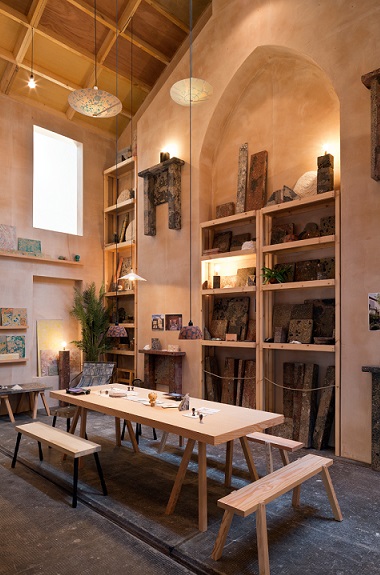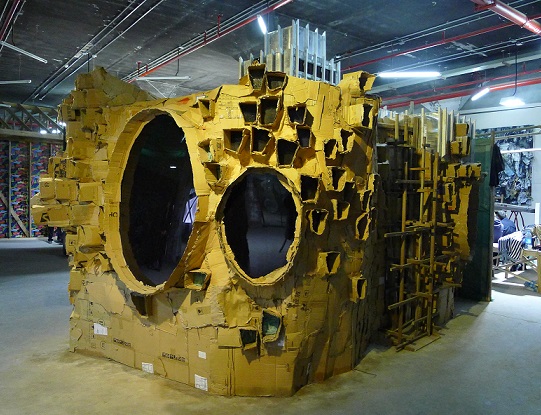Reviews & Articles
Architecture’s Challenge
John BATTEN
at 9:42am on 26th January 2016



Captions:
1. Assemble’s A Showroom for Granby Workshop (2015) at the Tramway, for the Turner Prize 2015. Photo courtesy: Assemble/Ben Quinton.
2. Dennis Maher, Hole in the (Window of the) World House, mixed media, 2015. An installation at 2015 UABB, Shekou, Shenzhen. Photo courtesy: John Batten.
3. Rob Voerman, Shenzhen Entropy, mixed media, 2015. An installation at 2015 UABB, Shekou, Shenzhen. Photo courtesy: John Batten.
(原文以英文發表,題為〈建築的挑戰〉。
The success of Assemble, a collective of 18 young architects, winning the 2015 Turner Prize, the prestigious British visual art award, has been seen as blurring the boundaries of visual art and architecture. Not quite – architecture and art in all its forms have always been intimately entwined, as any good architect or artist appreciates.
In the world of visual art prizes, the future interloping of architecture is unlikely. Assemble did not win the award for an architectural design, but for a holistic, community, social, regenerative and visual approach to a part of Liverpool that had deteriorated after social unrest and rioting in the early 1980s. The Turner Prize judges cited that Assemble took “a ground-up approach to regeneration, city planning and development in opposition to corporate gentrification,” and that the collective “draw(s) on long traditions of artistic and collective initiatives that experiment in art, design and architecture. In doing so, they offer alternative models to how societies can work.”
Assemble’s award is not a challenge to art, but to architecture and urban planning.
At the Bi-City Biennale of Urbanism/Architecture (UABB) currently running in Shekou, Shenzhen a similar call for alternative – and urgent – urban planning is posited. Aaron Betsky, one of the biennale’s four curators, says that “This Biennale makes a simple argument: we have enough stuff. We have enough buildings, enough objects, and enough images.” His hope for better urban planning is reflected in a wish list for architecture’s reform: “…Architecture that reuses, reimagines, restages, and repurposes / Architecture that gathers together what is into the new / Architecture that does not use up natural resources, but makes them available to all / Architecture that forms a collage or assemblage / Architecture that works tactically to liberate the city / Architecture that is strangely familiar.”
But, any radical reform of society’s need to build, expand and ‘develop’ must address social and political realities. As I sat through the UABB’s opening talks and seminar sessions and looked at the displays, not one speaker or exhibit explored capitalism’s need for consumption or creativity’s desire for diversity. A radical shift in urban planning needs a commensurate change in people’s thinking. The urgency of the issue is emphasized as large urban areas become unlivable. China’s noxious air pollution is no longer occasional, but a permanent feature and frankly unsustainable. Such mass environmental crisis (unlike Liverpool’s localized degeneration) will inevitably trigger social unrest and force decision-makers to “alternatives models to how societies can work.”
Two artists exhibiting at the UABB offering a similar collaborative approach and innovative use of old material as Assemble is Rob Voerman (Holland) and Dennis Maher (USA). Each artist constructed elaborate, provocative and beautiful structures from an assemblage of objects – each with homely features, but also anticipating a dystopian future. So, is architecture learning from and embracing visual art and design’s challenge – or, waiting for society’s reactive backlash?
Links for further information:
2015 Bi-City Biennale of Urbanism\Architecture
Dennis Maher
Rob Voerman
This article was originally published in Perspective architectural magazine, February 2016.
原文刊於Perspective,2016年2月。
|
|
|
|
|
|
